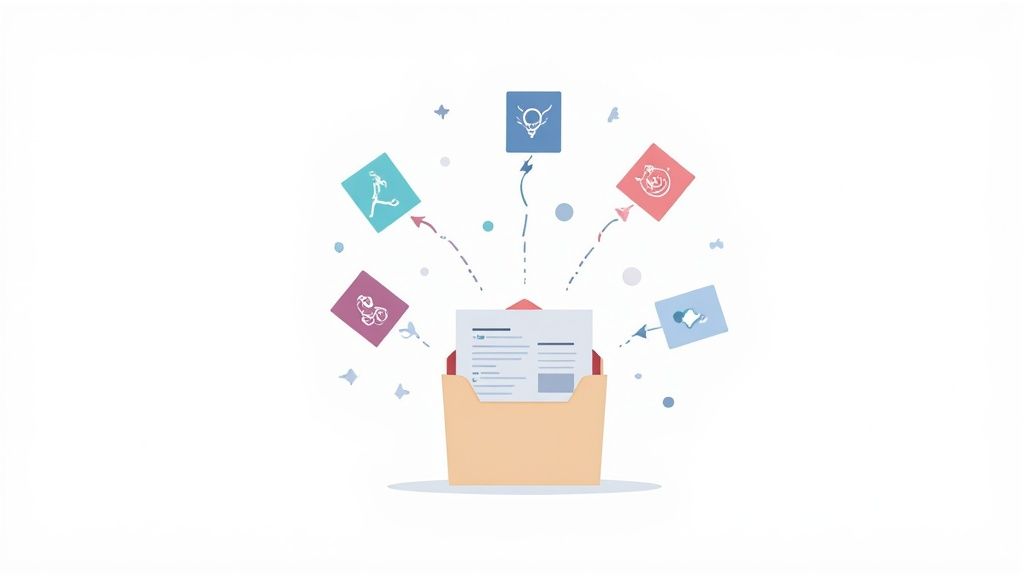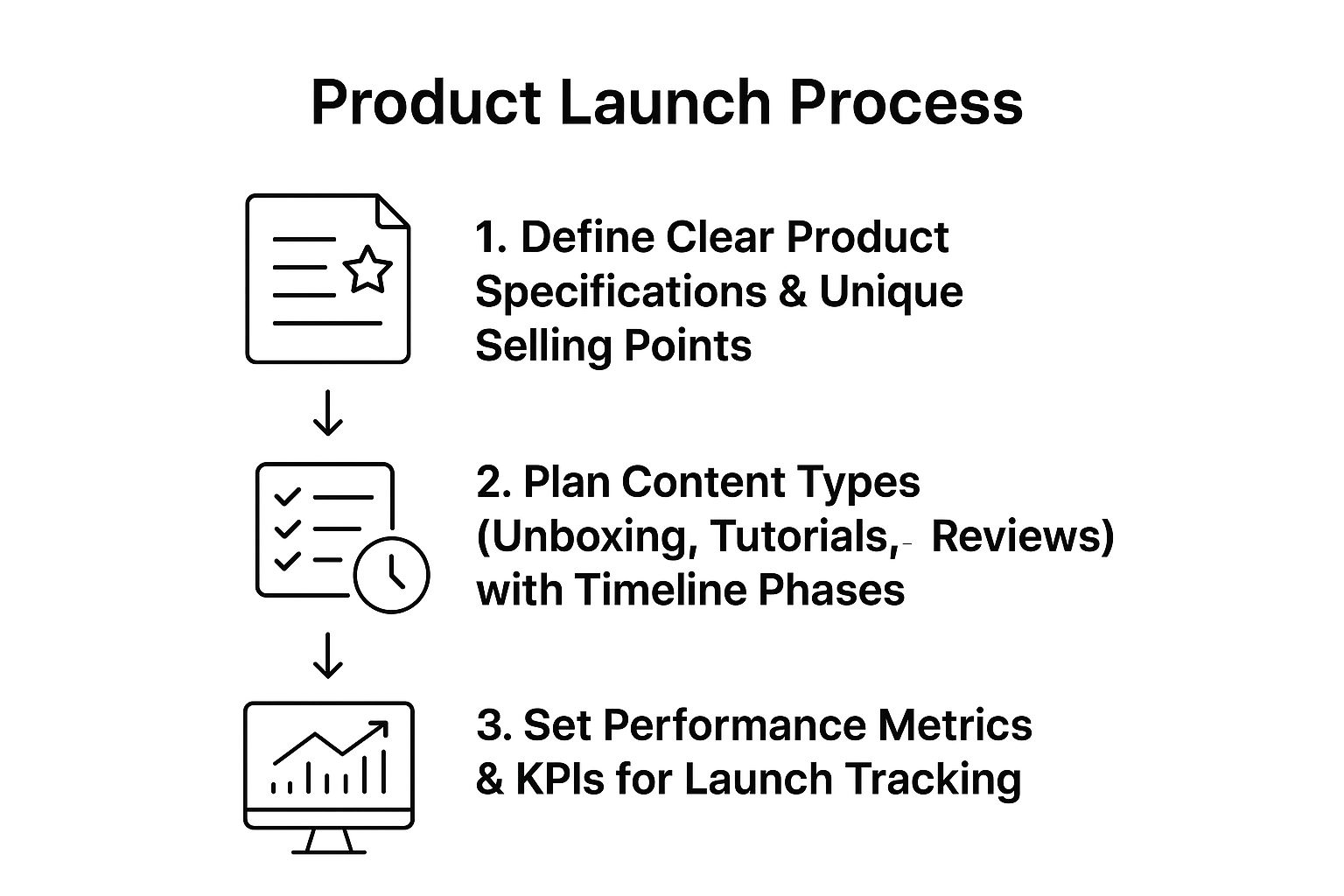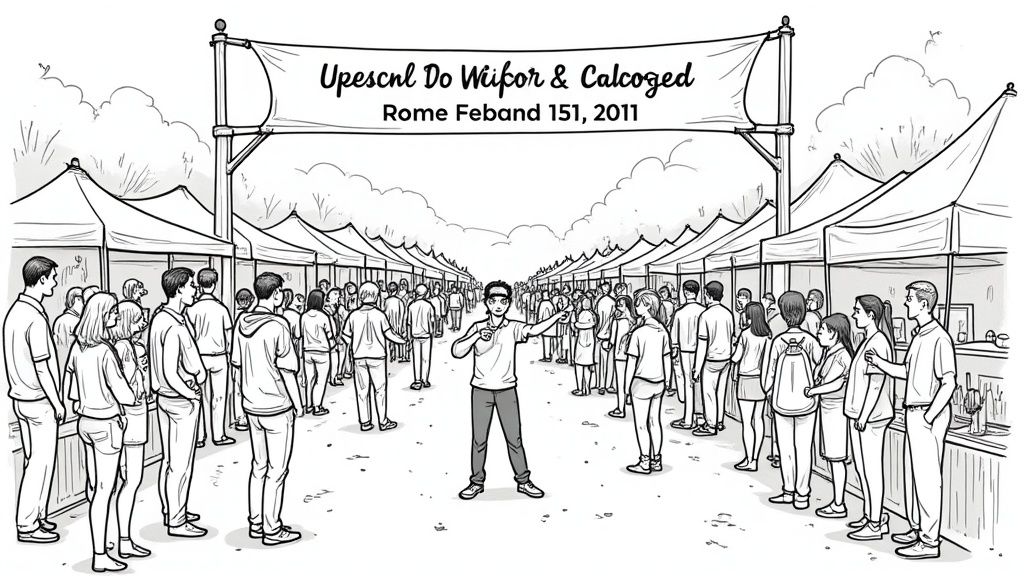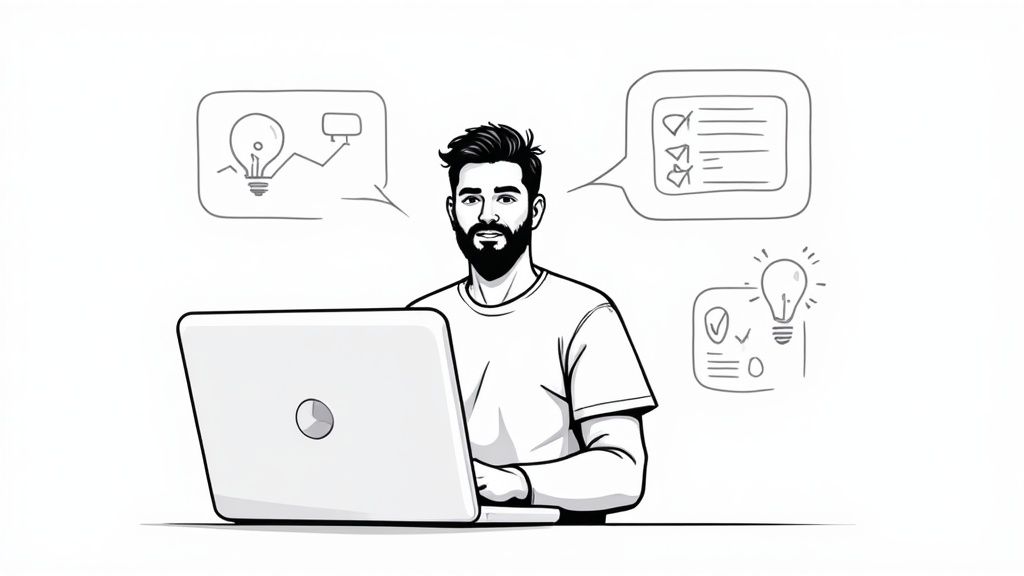
6 Influencer Brief Examples to Master Your Campaigns in 2025
Published
In influencer marketing, success isn't just about finding the right creators; it's about equipping them with a clear, compelling vision. A well-crafted brief is the strategic blueprint that transforms a simple collaboration into a powerful campaign. It aligns goals, sets clear expectations, and empowers influencers to create their best, most authentic content. Too often, brands provide vague instructions that lead to generic posts and lackluster results, wasting both budget and opportunity.
This guide moves beyond theory, offering a deep dive into six distinct, actionable influencer brief examples. We will dissect each template, revealing the strategic thinking behind its structure and providing replicable tactics you can immediately apply. You will see firsthand how a detailed brief for a product launch differs from one designed for generating user-generated content or promoting a holiday sale. Prepare to learn how to build briefs that not only guide but also inspire, ensuring your next influencer partnership achieves its full potential and delivers measurable impact. This is your playbook for turning a good idea into a great campaign.
1. The Product Launch Campaign Brief: Driving Hype and First-Day Sales
Launching a new product requires a finely tuned strategy to cut through the noise. This type of influencer brief is specifically engineered to generate immediate buzz, create authentic social proof, and drive crucial first-day sales. Unlike ongoing brand awareness campaigns, its focus is on creating a concentrated wave of excitement timed perfectly with your product's release.
The core of this brief is structured, sequential content. It guides influencers through a narrative that builds anticipation and provides value to their audience. Key content pillars often include unboxing videos, "first impression" stories, and detailed reviews, all designed to build momentum right from day one. This makes it one of the most powerful influencer brief examples for brands focused on tangible launch metrics.
Strategic Breakdown and Application
The effectiveness of a product launch brief hinges on its clarity and precision. The goal is to equip the influencer with everything they need to become a genuine advocate, while ensuring their content aligns with the launch's strategic goals.
- When to Use It: This brief is essential for new product releases, seasonal collection drops, or major product updates where generating initial sales velocity is the primary objective.
- Key Benefit: It converts influencer creativity into a direct sales driver. By providing clear talking points and a structured content timeline, you can coordinate a multi-influencer push that feels organic yet is highly strategic.
- Actionable Takeaway: Clearly define your unique selling propositions (USPs) and provide influencers with "storytelling prompts" rather than rigid scripts. For example, instead of saying "mention our new X-feature," ask them to "show how the new X-feature solves a problem you've had with older models."
This infographic outlines the foundational three-step process for structuring a high-impact product launch brief.

Following this sequential process ensures your brief is built on a solid strategic foundation, moving from product specifics to content execution and finally to measurable results.
2. The Brand Awareness Campaign Brief: Building Long-Term Brand Equity
When the goal isn't an immediate sale but lasting recognition, the brand awareness campaign brief takes center stage. This type of brief is designed to embed your brand's values, mission, and identity into the cultural conversation. Unlike a product launch, success is measured by recall, sentiment, and share of voice rather than direct conversion metrics.
The strategy here is rooted in authentic storytelling and long-term partnerships. The brief empowers influencers to become true brand ambassadors, translating your core message into content that resonates emotionally with their audience. It prioritizes creative freedom within a clear framework of brand values, making it one of the most essential influencer brief examples for building a durable and respected brand presence.
Strategic Breakdown and Application
A successful brand awareness brief acts as a compass, not a map. It guides influencers toward a shared narrative destination while allowing them the flexibility to choose their own path, ensuring the content feels genuine and non-transactional.
- When to Use It: This brief is ideal for brands entering a new market, rebranding, or aiming to strengthen their market position. It's also perfect for mission-driven companies, like Patagonia or Dove, whose brand identity is inseparable from their values.
- Key Benefit: It fosters deep, emotional connections between the audience and the brand, leading to greater loyalty and trust over time. This approach builds brand equity that can pay dividends long after the campaign ends. If you're looking to build out your own approach, you can learn more about crafting effective brand awareness strategies on influencermarketingjobs.net.
- Actionable Takeaway: Instead of dictating posts, provide a "Brand Ethos" kit. This should include your mission statement, key brand values, visual mood board, and examples of brand-aligned messaging. Encourage influencers to interpret these elements in their own voice, ensuring consistency in spirit but variety in execution. For instance, ask them to "share a personal story that reflects our brand value of perseverance."
3. The Event Promotion Brief: Building Buzz and Driving Attendance
An event promotion brief is a time-sensitive tool crafted to generate excitement and drive attendance for a specific occasion, whether it's an in-person conference like SXSW, a virtual summit, or a major festival like Coachella. This type of brief is all about creating urgency and a powerful sense of FOMO (fear of missing out), turning influencers into enthusiastic ambassadors who encourage their followers to participate.
Unlike evergreen content, this brief focuses on a specific timeline with clear calls-to-action for ticket sales, registration, or tune-ins. The goal is to build a crescendo of conversation leading up to the event, maintain momentum during it, and extend the buzz afterward. It’s one of the most effective influencer brief examples for converting audience engagement into physical or virtual attendees.

Strategic Breakdown and Application
The success of an event promotion brief depends on creating a multi-stage content plan that builds and sustains excitement. It must provide influencers with the necessary details while empowering them to share their genuine enthusiasm for the experience. The strategy moves from generating awareness to driving direct action.
- When to Use It: Essential for music festivals, tech conferences, trade shows, product launch events, and virtual summits. It's the go-to choice anytime your primary goal is to fill seats or boost digital viewership for a time-bound event.
- Key Benefit: It manufactures authentic hype and social proof at scale. By coordinating influencer posts, you can dominate social conversations, making your event seem like the place to be and driving a tangible increase in registrations and ticket sales.
- Actionable Takeaway: Implement a tiered content schedule: Pre-Event (announcements, ticket giveaways, "what I'm excited for" content), During-Event (live stories, behind-the-scenes access, real-time updates), and Post-Event (recap videos, key takeaways, "best moments" content). This extends the campaign's value far beyond the event date itself. Providing influencers with exclusive access or a unique experience is another powerful way to generate compelling content, as seen in many successful influencer marketing campaigns.
4. The Seasonal/Holiday Campaign Brief: Tapping into Timely Moments
Seasonal and holiday campaigns require a brief that leverages the powerful combination of timing, emotion, and established consumer behavior. This type of brief is designed to align brand messaging with specific cultural moments like Christmas, back-to-school season, or summer vacation, turning timely relevance into tangible results. Unlike evergreen content, its strength lies in its cyclical and highly predictable nature.
The foundation of this brief is capturing a specific seasonal mood or need. It guides creators to produce content that feels native to the season, such as holiday gift guides, back-to-school hauls, or summer adventure vlogs. This approach makes the brand an integral part of the consumer's seasonal experience, making it one of the most effective influencer brief examples for retail, beauty, and CPG brands aiming to capitalize on peak shopping periods.
Strategic Breakdown and Application
A successful seasonal brief goes beyond just mentioning the holiday; it equips the influencer to integrate the product authentically into their audience's seasonal traditions and activities. The goal is to make the brand synonymous with the feeling of that specific time of year.
- When to Use It: This brief is ideal for major holidays (Christmas, Valentine's Day), shopping seasons (Black Friday, Back-to-School), and cultural events (start of summer, fall pumpkin spice season). Plan these campaigns at least 2-3 months in advance to secure top talent and allow for content production.
- Key Benefit: It connects your brand to pre-existing consumer spending habits and high emotional engagement. By aligning with a specific season, your message arrives when audiences are already primed to listen and make purchases related to that theme.
- Actionable Takeaway: Frame your product as a solution to a seasonal problem or an enhancement to a seasonal experience. Instead of saying, "Promote our new camera," ask an influencer to "Show how our camera's low-light feature captures the magic of your family's holiday light tour." This creates a narrative that resonates on an emotional level.
5. The Educational/Tutorial Campaign Brief: Building Trust Through Expertise
This knowledge-focused brief positions influencers not as advertisers, but as trusted educators. The strategy centers on providing genuine value to the audience through tutorials, "how-to" guides, and expert tips, with the brand or product seamlessly integrated as the tool for success. This approach builds deep-seated trust and brand authority by prioritizing audience empowerment over a direct sales pitch.
The foundation of this brief is authenticity and expertise. It empowers creators like those partnering with Skillshare, Adobe, or Canva to teach a skill or solve a problem using the brand's product. This transforms the campaign from a simple promotion into a valuable resource, making it one of the most effective influencer brief examples for brands in the software, education, or complex product spaces.

Strategic Breakdown and Application
The power of an educational brief lies in its ability to demonstrate a product's value in a real-world context. To succeed, the brief must arm the influencer with deep product knowledge while giving them the creative freedom to teach in their unique style.
- When to Use It: Ideal for products with a learning curve (like software or creative tools), B2B services, or any brand wanting to establish itself as a thought leader. It's also perfect for beauty brands showcasing complex makeup techniques.
- Key Benefit: It generates high-quality, evergreen content that audiences can return to, creating long-term value. This method builds brand loyalty by solving tangible problems for potential customers, moving beyond simple awareness.
- Actionable Takeaway: Provide influencers with a "problem/solution" framework. Instead of asking for a feature list, task them with creating a tutorial that solves a common pain point for their audience. A key component of building trust is effectively educating your audience; learn how to educate customers about your product to maximize the impact of your tutorial campaigns.
This brief format allows creators to produce content that is both helpful and promotional, as demonstrated in this Adobe Lightroom tutorial.
By focusing on education, brands can foster a more meaningful connection with their target market, positioning their product as an indispensable part of the user's journey.
6. The User-Generated Content (UGC) Campaign Brief: Building a Community-Powered Movement
The UGC campaign brief is less about directing a single creator and more about igniting a community-wide movement. Its primary goal is to empower influencers to inspire their followers to create and share their own content featuring your brand. This strategy shifts the focus from a one-to-many broadcast to a many-to-many conversation, leveraging authenticity and social proof at a massive scale.
This brief type excels at building a repository of authentic content while fostering a deep sense of community. Instead of asking an influencer to simply review a product, you’re asking them to launch a challenge, start a trend, or issue a creative call-to-action that gets their audience involved. This makes it one of the most effective influencer brief examples for brands looking to generate organic reach and build lasting brand loyalty.
Strategic Breakdown and Application
A successful UGC campaign brief is built on simplicity, accessibility, and a compelling incentive. The influencer is the catalyst, but the true stars are their audience members. The brief must equip the influencer to make participation feel easy, fun, and rewarding for everyone.
- When to Use It: This brief is ideal for building brand community, gathering authentic social proof, and launching viral marketing trends. It works exceptionally well for visually appealing products (like Starbucks' cup art) or experience-based services (like GoPro's adventure contests).
- Key Benefit: It multiplies your content creation efforts exponentially and generates highly credible social proof directly from consumers. For UGC campaigns, focusing on strategies that genuinely work is paramount, as detailed in these proven ways to boost social media engagement. This approach turns passive followers into active brand participants.
- Actionable Takeaway: Design a low-barrier-to-entry concept. Instead of asking for a professional-quality video, encourage simple phone-shot clips. Provide a clear, unique hashtag and offer tiered rewards, such as featuring the best submissions on your brand’s official channels, to motivate participation. Building strong relationships with the initial influencers is key to getting enthusiastic participation. You can learn more about influencer relationship management to master this process.
Influencer Briefs: 6 Key Campaign Types Comparison
| Campaign Type | Implementation Complexity 🔄 | Resource Requirements ⚡ | Expected Outcomes 📊 | Ideal Use Cases 💡 | Key Advantages ⭐ |
|---|---|---|---|---|---|
| Product Launch Campaign Brief | Medium to High (detailed content & timing) | High (budget, product samples) | Immediate awareness & measurable sales | Launching new products with influencer demos | Drives sales impact; authentic validation; diverse formats |
| Brand Awareness Campaign Brief | Medium (consistent messaging, long term) | Medium to High (ongoing investment) | Long-term brand equity and emotional connection | Building brand authority and recognition | Builds credibility; emotional audience ties; quality brand content |
| Event Promotion Brief | High (time-sensitive coordination) | Medium (scheduling, real-time content) | Immediate action & engagement | Promoting events/festivals with time-bound calls-to-action | Drives attendance; real-time engagement; user-generated content |
| Seasonal/Holiday Campaign Brief | Medium (seasonal planning and timing) | Medium (early planning, promotions) | Timely engagement & sales boost | Seasonal or holiday-related product pushes | Capitalizes on shopping trends; creative timely storytelling |
| Educational/Tutorial Campaign Brief | High (content prep and expert input) | Medium to High (time, expertise) | Evergreen educational content & trust | Tutorials, how-to content, expertise positioning | Builds authority; high engagement; evergreen value content |
| User-Generated Content Campaign Brief | Medium (community management & incentives) | Low to Medium (prizes, moderation) | Organic reach & social proof | Encouraging audience participation & brand advocacy | Cost-effective; generates authentic content & social proof |
Crafting Your Next Winning Brief
Navigating the landscape of influencer marketing requires more than just a great product and a list of creators. As we've dissected throughout this guide, the foundational document that dictates the success or failure of a campaign is the influencer brief. The detailed influencer brief examples we’ve explored, from a dynamic product launch to a community-focused UGC campaign, all share a common thread: they achieve a delicate balance between providing clear direction and fostering creative freedom.
The era of dictatorial, overly restrictive briefs is over. Today’s most successful partnerships are built on mutual respect and a shared understanding of the campaign’s core purpose. Your role as a marketer is not just to issue instructions, but to provide a strategic blueprint that empowers influencers to do what they do best: connect authentically with their audience. This means moving beyond simple checklists and embracing a more holistic approach.
Key Takeaways for Actionable Briefs
To transform your briefs from simple documents into powerful collaboration tools, remember these core principles:
- Clarity is King: Your primary objective, whether it's brand awareness or event promotion, must be crystal clear. An influencer who understands the "why" behind the campaign is better equipped to deliver impactful content.
- Context Over Commands: Instead of just listing "do's and don'ts," provide context. Explain your brand voice, the target audience's pain points, and the key message you want to resonate. This gives creators the strategic insight they need to be effective brand storytellers.
- Structure for Success: As seen in our influencer brief examples, structure is your friend. Use clear headings, bullet points, and visual aids to make the information digestible. A well-organized brief is a respected brief.
- Empower, Don't Prescribe: Provide mandatory elements like specific links, discount codes, and FTC disclosure guidelines, but leave room for the influencer's unique style. The magic happens when their voice and your brand’s message merge seamlessly.
From Theory to Practice: Your Next Steps
Mastering the art of the brief is a continuous process of refinement. Start by auditing your current templates against the examples provided. Are you clearly defining your campaign goals? Are you providing enough creative context? Are your deliverables and timelines realistic and unambiguous?
By adopting these strategic frameworks, you not only set your campaigns up for success but also build a reputation as a sought-after collaborator. Influencers are more likely to partner with brands that demonstrate a clear vision and respect their creative expertise. This skill is invaluable, whether you're managing a global brand's strategy or building your career in this dynamic field. A powerful brief is more than just a document; it is the cornerstone of a successful, mutually beneficial partnership that drives real results.
Ready to put your skills to the test and find a role where you can craft winning campaigns? The most exciting opportunities in the industry are waiting for you. Explore dedicated listings for brand strategists, social media specialists, and agency experts on Influencer Marketing Jobs to find your next career move and shape the future of brand collaboration. Find your dream role today.